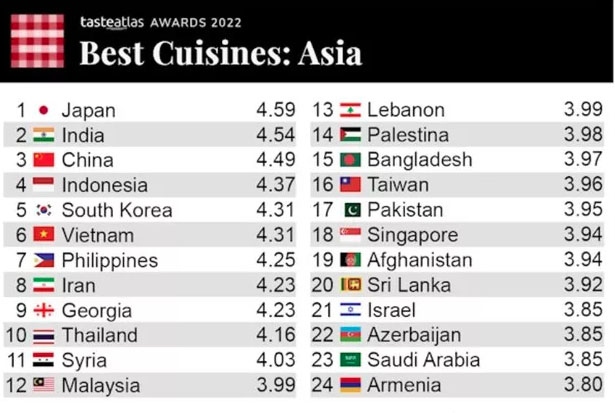Asian Food Ratings: Exploring the Best and Worst Cuisines
Asian cuisine is known for its rich diversity, vibrant flavors, and unique cooking techniques. From the spicy dishes of Thailand to the savory meals of Japan, Asian food has something for every palate. However, like any cuisine, there are foods that stand out as exceptional and others that are not as well-loved. In this article, we’ll explore the best and worst-rated foods across Asia, giving you a comprehensive overview of the flavors that dominate the region.

Best Asian Cuisines: A Journey Through Flavor
1. Thai Cuisine: A Perfect Balance of Sweet, Sour, Spicy, and Salty
Thai food is widely recognized for its balance of bold flavors. Dishes like Pad Thai, Tom Yum Soup, and Green Curry have earned global recognition. The use of fresh herbs, chili peppers, and lime creates a harmonious blend that is both exciting and refreshing. Thai food is beloved for its combination of sweet, sour, salty, and spicy elements, making each meal a burst of flavor.
2. Japanese Cuisine: Precision in Every Bite
Japanese food is the epitome of refinement, with dishes like Sushi, Sashimi, and Ramen dominating the world stage. The focus on high-quality ingredients and precise preparation methods elevates Japanese cuisine to an art form. Whether it’s the delicate sushi rolls or the comforting ramen bowls, Japanese food has a reputation for simplicity and excellence.
3. Chinese Cuisine: Diversity Across Regions
Chinese food is as varied as the country itself. From the bold Sichuan flavors, known for their fiery spice, to the sweet and savory dishes of Cantonese cuisine, Chinese food offers an array of flavors to explore. Signature dishes like Peking Duck and Dim Sum are not only popular in China but have become international staples.

4. Indian Cuisine: Bold and Complex Spices
Indian food is all about bold, complex spices. The use of cumin, coriander, turmeric, and garam masala creates layers of flavors that are both rich and aromatic. Butter Chicken, Biryani, and Chole Bhature are some of the most popular dishes that showcase the depth of Indian cuisine. The variety of vegetarian and meat-based dishes ensures that there is something for everyone.
5. Vietnamese Cuisine: Fresh, Light, and Aromatic
Vietnamese food is known for its fresh ingredients, light textures, and aromatic herbs. Dishes like Pho, Banh Mi, and Goi Cuon (Vietnamese spring rolls) emphasize the use of herbs like basil, cilantro, and mint. The Vietnamese approach to food focuses on fresh, clean flavors, making it a favorite among health-conscious food lovers.
Worst-Rated Asian Foods: An Acquired Taste or Just Too Strange?
While many Asian dishes are beloved around the world, there are some that have received mixed reviews. These foods may be considered an acquired taste or simply not to everyone’s liking.
1. Balut (Philippines): A Fertilized Duck Egg
Balut, a popular street food in the Philippines, is essentially a fertilized duck egg that is boiled and eaten whole. While it’s a delicacy in the Philippines, it has earned a place on the “worst-rated” list for many due to its unusual appearance and texture. The sight of a partially developed embryo inside the egg can be unsettling for many people, making it a dish that is often described as a “love it or hate it” experience.
2. Durian (Southeast Asia): The King of Fruits
Durian is famous for its strong odor, which many people find off-putting. The scent has been described as a mix of rotten onions and turpentine. Despite its divisive aroma, durian is highly regarded in Southeast Asia, especially in countries like Thailand, Malaysia, and Indonesia. While the taste of the fruit can be sweet and creamy, its smell tends to overshadow its appeal for many.

3. Natto (Japan): Fermented Soybeans
Natto is a traditional Japanese dish made from fermented soybeans. It is known for its sticky, slimy texture and strong, pungent smell. The flavor is very earthy, and many people find it an acquired taste. While natto is a popular breakfast food in Japan, it is not a dish that everyone enjoys, especially outside of the country.
4. Kimchi (Korea): A Fermented Staple
Kimchi is a staple in Korean cuisine, made from fermented vegetables like cabbage and radish, often flavored with chili pepper, garlic, and ginger. For those unfamiliar with fermented foods, the sour and spicy taste of kimchi can be a bit overwhelming. However, it remains a favorite for many due to its health benefits and as a key component of Korean dishes.
5. Century Eggs (China): A Delicacy with a Dark Appearance
Century eggs, also known as thousand-year-old eggs, are preserved eggs that have been cured for several weeks or months. The eggs undergo a chemical process that turns the whites into a dark, gelatinous substance and the yolk into a dark green or black color. While some people enjoy the unique flavor, many find the appearance and strong flavor of century eggs off-putting.
Why Do Asian Foods Get Such Mixed Reviews?
Cultural Influence
The way food is perceived often depends on cultural context. What is considered delicious in one culture may seem strange to someone from another country. For instance, dishes like Fried Tarantulas in Cambodia or Insects in Thailand might seem unusual to foreigners, but they are considered delicacies in their respective regions.
A Different Approach to Flavors and Ingredients
Asian cuisines often use ingredients that are not common in Western dishes, such as fermented foods, unique spices, and meats that might be unusual in the West. This unfamiliarity can make the food hard to appreciate for those not accustomed to these flavors.
Acquired Taste
Many of the more controversial Asian dishes require an acquired taste. Foods like Kimchi, Natto, and Balut are often described as developing a taste for them over time. Once you understand the flavors and textures, these dishes become much more palatable.
How to Embrace Asian Cuisine?
Start with the Familiar
If you’re new to Asian cuisine, start with dishes that are widely loved around the world, such as Sushi, Dim Sum, or Pad Thai. These dishes are not only delicious but also offer a great introduction to the unique ingredients used in Asian cooking.
Be Open-Minded
Exploring Asian food requires an open mind and a willingness to try new things. Don’t be afraid to experiment with different flavors and textures. Even if some dishes don’t initially appeal to you, you might find that your taste evolves over time.
Learn About the Culture Behind the Food
Understanding the cultural significance behind each dish can enhance your dining experience. Many Asian foods have deep cultural roots and are tied to traditions that go back thousands of years. By learning about the history and significance of these dishes, you can better appreciate their complexity and uniqueness.
Frequently Asked Questions (FAQs)
What is the most popular Asian cuisine in the world?
The most popular Asian cuisine worldwide is Chinese food, particularly dishes like Dim Sum, Peking Duck, and Sweet and Sour Pork.
Why do some Asian foods have a strong odor?
Many Asian foods, such as Durian and Natto, have a strong odor due to the use of fermentation or the natural properties of certain ingredients. These strong smells are often part of the cultural identity of the food and are an essential part of the flavor profile.
Is it safe to eat Balut?
Yes, Balut is safe to eat when properly cooked. It is a popular street food in the Philippines and is enjoyed by many. However, the unique appearance of the egg may not be suitable for everyone.
Which Asian foods are healthiest?
Foods like Pho, Sushi, and Banh Mi are often considered healthy due to their fresh ingredients and balance of flavors. Many Asian cuisines focus on incorporating vegetables, lean proteins, and fresh herbs, making them nutritious options.
Conclusion: A Flavorful Adventure Awaits
Asian cuisine offers an incredible range of flavors, from the sweet and spicy dishes of Thailand to the refined elegance of Japanese food. While some dishes are adored worldwide, others remain a matter of personal taste. Whether you’re exploring the best-rated dishes or braving the worst-rated foods, Asian cuisine promises a culinary adventure filled with bold, exciting, and sometimes surprising experiences. So, the next time you find yourself at an Asian restaurant or trying a new dish at home, embrace the journey of flavors and textures—it might just be your next favorite meal!




